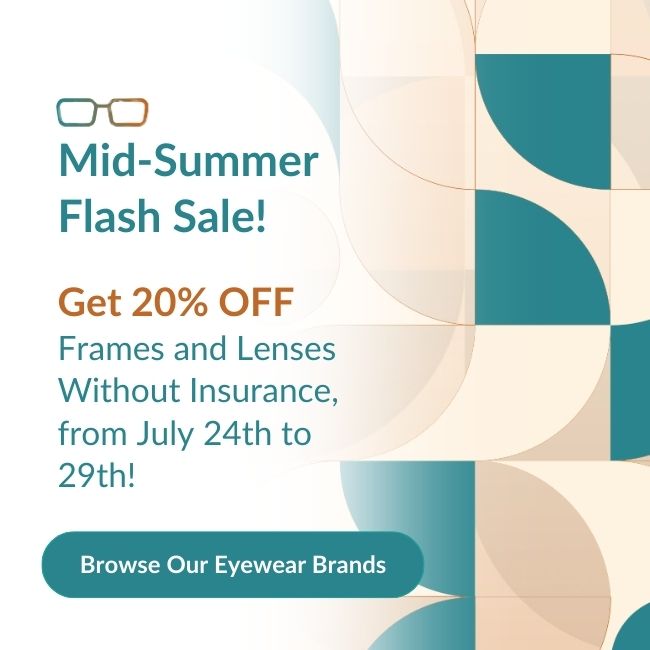Although changes in our vision can develop for several reasons, needing to update your vision prescription is generally the most common. Listening to what your eyes need helps prevent unnecessary stress and fatigue, preserving your vision and eye health.
Some symptoms to look out for that suggest it may be time for glasses can include:
- Frequent headaches
- Eye strain and fatigue
- Squinting to see clearly
- Trouble seeing at night
- Blurry or double vision
- Difficulty seeing small print
- Halos around lights
- Persistent eye pain
- Frequent eye rubbing
- Sensitivity to light
If you’re nodding your head to any of these signs, it’s worth scheduling an appointment for a routine eye exam.
Frequent Headaches
A dull, lingering pain after working on your laptop, reading a book, or scrolling through your phone may be a sign of eye strain caused by uncorrected vision.
Headaches caused by eye strain are often felt around the eyebrows, temples, or even across the forehead. The discomfort usually starts as a dull ache and can intensify as the day goes on, especially after prolonged periods of focusing.
Eyestrain headaches might feel like a band of pressure around your head or a persistent throbbing. They typically ease once you rest your eyes or step away from visually demanding activities.
Without the support of corrective lenses, your eyes work harder to focus, straining your eye muscles and leading to headaches that won’t go away.
Eye Strain & Fatigue
Eye strain and fatigue occur when your eyes are overworked, often because of tasks that involve periods of extended focus, like reading, computer work, or staring at your phone.
These tasks require your eyes to maintain constant focus, which can be particularly challenging if your vision isn’t as clear as it should be.
Persistent eye fatigue might mean your eyes are working harder than they need to, signaling that corrective lenses could help.
Squinting to See Clearly
If you find yourself squinting to read lecture slides or street signs, this is your eyes’ way of compensating for poor vision.
Squinting tends to temporarily improve your focus by reducing the amount of light entering your eyes, but it’s a band-aid solution that isn’t sustainable.
Constantly squinting can strain your eye muscles, leading to discomfort and fatigue.
Over time, this may become a habitual response to blurry vision, and is a strong indicator it’s time for an updated routine eye exam.
Trouble Seeing at Night
Struggling to see after dark or in low-light conditions may be a symptom of an underlying refractive error, such as nearsightedness, where distant objects appear blurry, or astigmatism, which distorts vision at all distances.
Both refractive errors affect your ability to focus clearly in dim environments, making everyday tasks like night driving challenging and unsafe.
Wearing the right prescription glasses tailored to your vision needs addresses these concerns, improving your ability to see in all lighting conditions and preserving your overall safety and quality of life.

Blurry or Double Vision
More than just a minor annoyance, blurry or double vision is a clear signal that something’s off with your eyesight. It often indicates that your eyes are struggling to focus properly, and it affects your ability to see clearly and sharply at various distances.
There are several underlying causes of blurry or double vision. A common one is refractive errors, like myopia (nearsightedness) or hyperopia (farsightedness)—which are treated by getting glasses!
Glasses correct blurry vision by adjusting how light enters your eyes, allowing you to perceive the world more clearly.
Difficulty Reading Small Print
If you’re holding your book, phone, or menu farther away than usual to read it, this difficulty reading small print could be a sign of presbyopia. Presbyopia is a common condition where the lenses of your eyes gradually lose their elasticity with age or strain, affecting your ability to focus on nearby objects.
While it often occurs in older adults, young adults may experience it for other reasons too.
Reading or multifocal glasses help reduce the stress on your eyes, making reading comfortable and enjoyable again at varying distances.
Halos Around Lights
If you frequently notice halos around lights, this may be a sign that your eyes are struggling to focus light correctly. This issue is often linked to astigmatism.
Over time, it can lead to increased eye strain, headaches, or difficulty seeing clearly, especially in low-light conditions.
Persistent Eye Pain
Sometimes your eyes can experience mild discomfort or irritation from conditions like dry eyes or allergies. However, persistent eye discomfort or pain isn’t normal.
Persistent eye pain might indicate your eyes are working harder than they should to focus. Struggling to adjust your eyes to varying distances or lighting conditions can lead to eye strain and discomfort over time.
Frequent Eye Rubbing
Although occasional eye rubbing is often linked to tiredness or allergies, doing so frequently can suggest an underlying vision concern.
When your eyes struggle to focus or experience strain for extended periods, this can lead to uncomfortable sensations, triggering an instinctive urge to rub them, which we don’t recommend.
Rubbing your eyes might temporarily relieve discomfort, but it doesn’t address the root cause.
Increased Sensitivity to Light
If you find sunlight or computer screens feel painfully bright, your eyes may be struggling to focus properly or are being exposed to excessive glare, straining your eye muscles. This can also point to astigmatism, which glasses help correct.
Glasses equipped with anti-reflective lens coatings can help improve sensitivity by reducing glare and alleviating discomfort.
Take A Step Toward Clear Vision
Glasses are a tool to help you see clearly. Although choosing not to wear them won’t necessarily worsen your eyesight, you may experience ongoing discomfort that can affect your overall quality of life.
If any of the signs above sound familiar, we encourage you to schedule a visit with our Eclectic Eyewear team for a routine eye exam.


